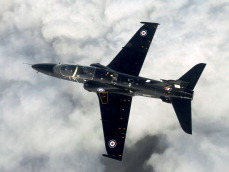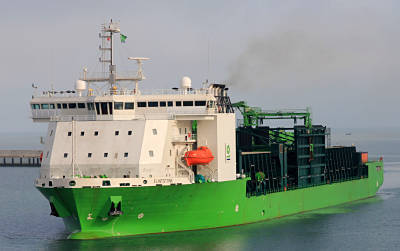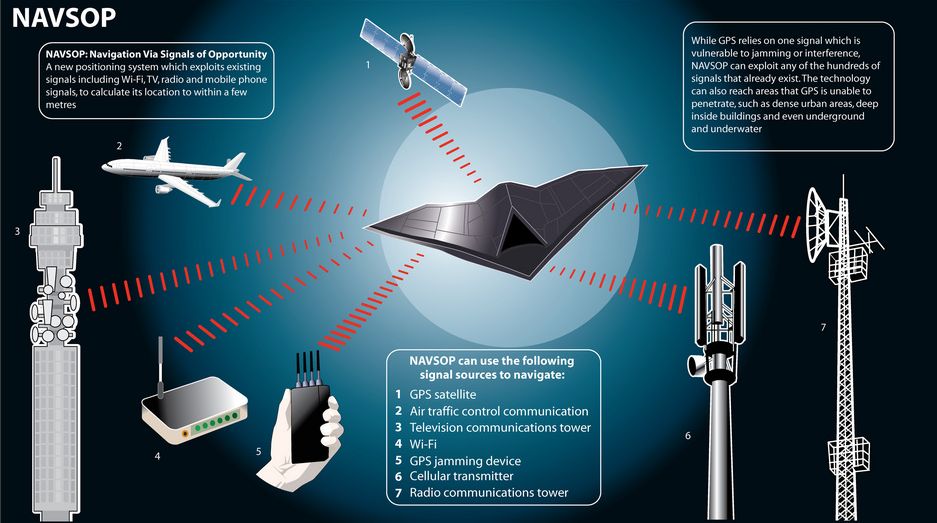ABOARD THE USS RHODE ISLAND, Aug. 23, 2010 — On a recent sun-soaked morning hundreds of miles off Florida’s Atlantic coast, this Trident ballistic missile submarine surfaced for an unusual operation.
About a dozen journalists, many representing the military, watched from a contracted 250-foot support vessel as the sleek, black back of the submarine ascended above gentle waters in the open ocean and maneuvered alongside the boat. With just a few feet separating the two vessels and a Coast Guard cutter on watch, the support boat’s crew extended a catwalk bridge from its deck over to the Rhode Island.
A pod of dolphins played in the wake below as the journalists hobbled quickly over to the submarine. “Keep moving! Keep moving!” a submariner shouted, as a slowdown easily could lead to a foot or leg getting caught and injured, or causing a “man overboard” situation.
After exchanging quick greetings with the attending crew, the journalists climbed in turn through the hatch and down the steep, narrow ladder into the belly of the sub.
The Aug. 16 media visit offered a rare glimpse into what is known as “the silent service,” the community of Navy submariners who man and control the vessels that carry weapons under the sea. Journalists were invited to embed on the Trident after a military-commissioned survey showed that Americans know less about the Navy than the other services, and even less about submarines and those who serve on them, Lt. Rebecca Rebarich, public affairs officer for Submarine Group 10 at King’s Bay Naval Base, Ga., said.
The visit also coincided with increasing media attention on the submarine community following two major changes in Navy policy earlier this year: lifting the ban on women serving on submarines, and ending smoking on subs. The Navy chose 21 women early this summer to begin the 15-month training to serve on subs beginning in the fall of 2011. The smoking ban takes effect Jan. 1.
The Nuclear Triad
The Rhode Island is an Ohio-class submarine, the largest model in the U.S. fleet. At about 560 feet long and 42 feet in diameter, Ohio-class submarines hold 24 Trident ballistic missile tubes and four torpedo tubes. The Navy’s fleet of 14 SSBNs is based at King’s Bay and at Bangor, Wash.
The Trident subs, known as “boomers,” are powered by a single-shaft nuclear reactor. They can carry more than 16 tons, travel more than 20 knots — more than 23 miles per hour — and submerge more than 800 feet, according to Navy officials who keep their exact capabilities secret.
Part of the nuclear deterrent triad along with land-based intercontinental ballistic missiles and Air Force bombers, the Tridents’ sole mission is to deter a nuclear attack through its ultimate strike capabilities. A command from the president, passed through U.S. Strategic Command and ultimately to the ship’s captain, allows the crew to fire a long-range ballistic missile in a matter of minutes.
The Trident is a three-stage missile powered by solid rocket motors. It’s about 44 feet long and 7 feet in diameter, and weighs about 120,000 pounds, according to information provided by public affairs officials. Each has a range of more than 4,000 miles.
Touring the Boomer
The boomer’s design of massive missile tubes occupying the bulk of the midsection and extending vertically through four levels is the focal point of the vessel and a reminder of the singular mission of deterrence. The space between the tanks makes up the hallways. Small rooms, such as the nine-person enlisted berthing cabins — three sets of bunks with three beds each — and a couple of bathrooms, known as “heads,” are tucked in between.
The galley and crew’s mess are nearby on the same level and they present a nearly constant hub of activity. The Navy is known for providing good meals, and if the Rhode Island is an indication, submarines are among the best. The boat’s head chef, Petty Officer 1st Class Daniell Pinero, a former chef for the secretary of defense, and his crew provide three hot meals each day as well as late-evening snacks.
Stocking the galley for a three-month tour is no small undertaking. A lengthy shopping list includes, for example, 530 pounds of coffee, 22,140 eggs, 800 pounds of butter, 504 bags of microwave popcorn and 21,000 biodegradable weights to sink trash in the ocean. Because all food must be purchased and stored before the start of the tours, fresh produce is a scarce commodity enjoyed in the early days of each patrol. Still, there are few complaints. Pizza, spaghetti, turkey and dressing, ham and sweet potatoes, rolls, cakes and pies -– all homemade -– were provided during the media visit.
“I gain 10 pounds every time we go out,” Cmdr. Robert J. Clark, commanding officer and captain for one of the Rhode Island’s two rotating crews, said. Exercise equipment is placed sporadically around the ship – cardio machines and free weights – wherever there is a little spare room. But as Clark and others noted, any weight gained on board is lost during shore duty.
A Tight-knit Community
Clark is the commanding officer and captain of the Rhode Island’s blue crew, which carried the media representatives during their visit. His executive officer, or second in command, is Lt. Cmdr. Paul Pampuro.
Each Trident sub includes two crews of 15 officers and about 140 enlisted men, known as the blue and gold crews, each with its own commanding officer. Each crew rotates onto submarine duty about every 112 days, while the other crew stays at base for training and preparation for the next time at sea.
A snapshot of the crew is one that is young, smart, and committed to the mission and fellow crewmembers. The average age is 23, and many have engineering, math or science degrees. Ask submariners what they enjoy most about their work and the answer usually is the camaraderie of a tight-knit community, the highly specialized work, and the importance of the mission.
Lt. Colin Myers is a Naval Academy graduate who serves as the sub’s main propulsion assistant, assistant security manager, intelligence officer and ship self-assessment coordinator. He said he enjoys the Rhode Island because of the quality of the crew.
“These are a lot of really smart guys,” Myers said. “Some are double majors. It’s a volunteer force, so they really want to be here.” He added that because the submarine force is small, there are many opportunities and officers advance quickly; some obtain command by their mid-30s.
Serving on a submarine -– mostly submerged for three months with only periscopes to see out — also can be stressful, tedious and boring, submariners say. The days are long, sleep is minimal, and submariners are surprisingly disconnected. E‑mail is sporadic, only coming through every couple of days when an antenna is connected to the sail — a submarine’s exterior tower-like structure — and attachments are not allowed. There are no phone calls; no text messages. Still, some say they don’t mind being disconnected.
“You either love it or hate it,” said Petty Officer 2nd Class Calvin Hurt, the torpedo room supervisor.
Reality in Mission Control
Around 9 p.m., some off-duty crew members gather in the mess to wind down with a movie. The chef has made pizza and Buffalo wings, and someone pops in the 1990 movie, “The Hunt for Red October.”
“This is a comedy!” a long-time submariner proclaimed as the crew laughed at the creative license Hollywood took in producing the action-packed drama of a Trident submarine executive officer, played by Denzel Washington, who leads a mutiny after the captain, played by Gene Hackman, decides to launch a ballistic missile at a perceived Soviet threat. In the real world of Trident subs, protocol and procedures rule. In the control room, the sub’s nerve center, each area is manned in six-hour shifts with full attention on the equipment. The mission is to keep the boomer undetected, while detecting everything else around it.
In the front of the room, three enlisted men watch location and conditions on monitors while two of them do their part to “drive” the sub with long-handled steering wheels. Behind them, two others man multiple screens that track sonar and acoustics, analyzing sounds from as far away as 75,000 yards. Behind them, an officer always is watching through the periscope, and those images are provided on computer screens. Coordinates are constantly being called out above the sound of the equipment, and the standard response “very well” acknowledges receipt of the information.
Many of the screens are marked “Secret,” and all of the crew has security clearances. While each has his own job specialty, all are cross-trained and expected to be able to do multiple jobs, Rolinger said. “Everyone is an expert at damage control,” he said, noting the crew practices multiple drills -– from firing torpedoes to putting out fires –- several times per week.
During a missile release test, Clark stands in the center of the control room receiving information from every possible data point, some relayed repeatedly to ensure conditions have not changed. “All missiles will be released,” he announces along with the exact time so all clocks are synchronized to the exact second.
“This is the captain. This is an exercise,” Clark says over the sub’s speaker system.
Down the hall, two crew members man the missile control center, divided between “launcher” and “fire” controls. The U.S. ballistic missile fleet fires four test missiles each year, and has had 124 consecutive successful tests in 20 years, Cmdr. Michael Sowa, deputy chief of staff of strategic weapons for Submarine Group 10, said. The tests also serve as a deterrent, and foreign countries are notified before testing begins, he added.
“The system works well, even better than it was designed to work,” Sowa said. The British, French, and Russians also test ballistic missiles, and the Chinese are developing the capabilities, he said.
“The SSBN mission is to deter,” Sowa added. “So, if we must launch, we’ve failed our mission.”
Earning Their Dolphins
A more likely scenario than the release of a Trident missile is the release of a torpedo. Back toward the front end of the sub and down the stairs next to the smoking room, two crew members man the torpedo controls, watching red and green lights for the status of torpedoes that lie horizontally on hydraulic lifts. They hold several exercises each week to practice firing torpedoes, and avoiding torpedoes from an enemy.
“Everything we do down here, we get one minute to do it in,” Hurt said. A submariner for four years, he said he now loves the job that is very trying for the first two years.
Three sailors earned the title of submariner here on Aug. 16 when they were presented the coveted Dolphin pins, which come only after a new crew member proves within 10 months that he has a basic understanding of everything on the boat. Clark presented the pins during a ceremony in the crew’s mess.
“The whole thing is a little overwhelming,” Petty Officer 3rd Class Patrick Iverson, 20, of Freeport, Ill., said after receiving his pin. “With this, you know you’ve earned the respect of your fellow shipmates.”
Petty Officer 1st Class Herwin Marcia, who has served on submarines for 13 years, still remembers the stress of being new on a submarine.
“It’s a big culture shock,” he said. “You have to catch up to where you can support everyone else. You have to be ready when called on. We don’t have time to wait.”
Source:
U.S. Department of Defense
Office of the Assistant Secretary of Defense (Public Affairs)

 von
von 


